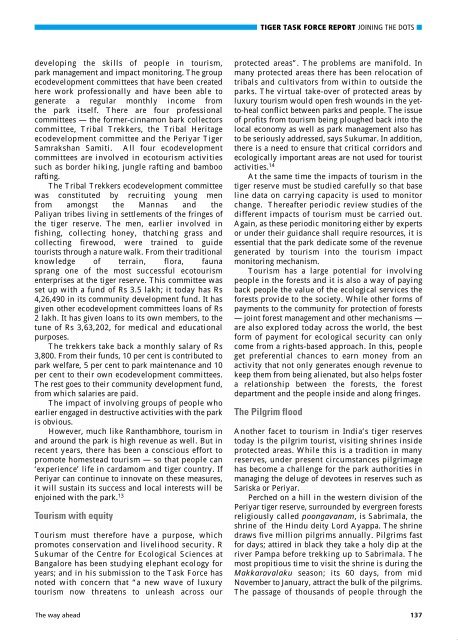Report of the Tiger Task Force - PRS
Report of the Tiger Task Force - PRS
Report of the Tiger Task Force - PRS
Create successful ePaper yourself
Turn your PDF publications into a flip-book with our unique Google optimized e-Paper software.
TIGER TASK FORCE REPORT JOINING THE DOTS ■developing <strong>the</strong> skills <strong>of</strong> people in tourism,park management and impact monitoring. The groupecodevelopment committees that have been createdhere work pr<strong>of</strong>essionally and have been able togenerate a regular monthly income from<strong>the</strong> park itself. There are four pr<strong>of</strong>essionalcommittees — <strong>the</strong> former-cinnamon bark collectorscommittee, Tribal Trekkers, <strong>the</strong> Tribal Heritageecodevelopment committee and <strong>the</strong> Periyar <strong>Tiger</strong>Samrakshan Samiti. All four ecodevelopmentcommittees are involved in ecotourism activitiessuch as border hiking, jungle rafting and bamboorafting.The Tribal Trekkers ecodevelopment committeewas constituted by recruiting young menfrom amongst <strong>the</strong> Mannas and <strong>the</strong>Paliyan tribes living in settlements <strong>of</strong> <strong>the</strong> fringes <strong>of</strong><strong>the</strong> tiger reserve. The men, earlier involved infishing, collecting honey, thatching grass andcollecting firewood, were trained to guidetourists through a nature walk. From <strong>the</strong>ir traditionalknowledge <strong>of</strong> terrain, flora, faunasprang one <strong>of</strong> <strong>the</strong> most successful ecotourismenterprises at <strong>the</strong> tiger reserve. This committee wasset up with a fund <strong>of</strong> Rs 3.5 lakh; it today has Rs4,26,490 in its community development fund. It hasgiven o<strong>the</strong>r ecodevelopment committees loans <strong>of</strong> Rs2 lakh. It has given loans to its own members, to <strong>the</strong>tune <strong>of</strong> Rs 3,63,202, for medical and educationalpurposes.The trekkers take back a monthly salary <strong>of</strong> Rs3,800. From <strong>the</strong>ir funds, 10 per cent is contributed topark welfare, 5 per cent to park maintenance and 10per cent to <strong>the</strong>ir own ecodevelopment committees.The rest goes to <strong>the</strong>ir community development fund,from which salaries are paid.The impact <strong>of</strong> involving groups <strong>of</strong> people whoearlier engaged in destructive activities with <strong>the</strong> parkis obvious.However, much like Ranthambhore, tourism inand around <strong>the</strong> park is high revenue as well. But inrecent years, <strong>the</strong>re has been a conscious effort topromote homestead tourism — so that people can‘experience’ life in cardamom and tiger country. IfPeriyar can continue to innovate on <strong>the</strong>se measures,it will sustain its success and local interests will beenjoined with <strong>the</strong> park. 13Tourism with equityTourism must <strong>the</strong>refore have a purpose, whichpromotes conservation and livelihood security. RSukumar <strong>of</strong> <strong>the</strong> Centre for Ecological Sciences atBangalore has been studying elephant ecology foryears; and in his submission to <strong>the</strong> <strong>Task</strong> <strong>Force</strong> hasnoted with concern that “a new wave <strong>of</strong> luxurytourism now threatens to unleash across ourprotected areas”. The problems are manifold. Inmany protected areas <strong>the</strong>re has been relocation <strong>of</strong>tribals and cultivators from within to outside <strong>the</strong>parks. The virtual take-over <strong>of</strong> protected areas byluxury tourism would open fresh wounds in <strong>the</strong> yetto-healconflict between parks and people. The issue<strong>of</strong> pr<strong>of</strong>its from tourism being ploughed back into <strong>the</strong>local economy as well as park management also hasto be seriously addressed, says Sukumar. In addition,<strong>the</strong>re is a need to ensure that critical corridors andecologically important areas are not used for touristactivities. 14At <strong>the</strong> same time <strong>the</strong> impacts <strong>of</strong> tourism in <strong>the</strong>tiger reserve must be studied carefully so that baseline data on carrying capacity is used to monitorchange. Thereafter periodic review studies <strong>of</strong> <strong>the</strong>different impacts <strong>of</strong> tourism must be carried out.Again, as <strong>the</strong>se periodic monitoring ei<strong>the</strong>r by expertsor under <strong>the</strong>ir guidance shall require resources, it isessential that <strong>the</strong> park dedicate some <strong>of</strong> <strong>the</strong> revenuegenerated by tourism into <strong>the</strong> tourism impactmonitoring mechanism.Tourism has a large potential for involvingpeople in <strong>the</strong> forests and it is also a way <strong>of</strong> payingback people <strong>the</strong> value <strong>of</strong> <strong>the</strong> ecological services <strong>the</strong>forests provide to <strong>the</strong> society. While o<strong>the</strong>r forms <strong>of</strong>payments to <strong>the</strong> community for protection <strong>of</strong> forests— joint forest management and o<strong>the</strong>r mechanisms —are also explored today across <strong>the</strong> world, <strong>the</strong> bestform <strong>of</strong> payment for ecological security can onlycome from a rights-based approach. In this, peopleget preferential chances to earn money from anactivity that not only generates enough revenue tokeep <strong>the</strong>m from being alienated, but also helps fostera relationship between <strong>the</strong> forests, <strong>the</strong> forestdepartment and <strong>the</strong> people inside and along fringes.The Pilgrim floodAno<strong>the</strong>r facet to tourism in India’s tiger reservestoday is <strong>the</strong> pilgrim tourist, visiting shrines insideprotected areas. While this is a tradition in manyreserves, under present circumstances pilgrimagehas become a challenge for <strong>the</strong> park authorities inmanaging <strong>the</strong> deluge <strong>of</strong> devotees in reserves such asSariska or Periyar.Perched on a hill in <strong>the</strong> western division <strong>of</strong> <strong>the</strong>Periyar tiger reserve, surrounded by evergreen forestsreligiously called poongavanam, is Sabrimala, <strong>the</strong>shrine <strong>of</strong> <strong>the</strong> Hindu deity Lord Ayappa. The shrinedraws five million pilgrims annually. Pilgrims fastfor days; attired in black <strong>the</strong>y take a holy dip at <strong>the</strong>river Pampa before trekking up to Sabrimala. Themost propitious time to visit <strong>the</strong> shrine is during <strong>the</strong>Makkaravalaku season; its 60 days, from midNovember to January, attract <strong>the</strong> bulk <strong>of</strong> <strong>the</strong> pilgrims.The passage <strong>of</strong> thousands <strong>of</strong> people through <strong>the</strong>The way ahead 137
















